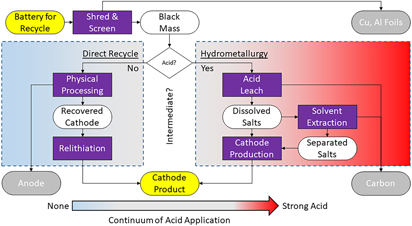Crossref Citations
This article has been cited by the following publications. This list is generated based on data provided by
Crossref.
Rosendahl, Knut Einar
and
Rubiano, Diana Roa
2019.
How Effective is Lithium Recycling as a Remedy for Resource Scarcity?.
Environmental and Resource Economics,
Vol. 74,
Issue. 3,
p.
985.
Gaines, Linda
2019.
Profitable Recycling of Low-Cobalt Lithium-Ion Batteries Will Depend on New Process Developments.
One Earth,
Vol. 1,
Issue. 4,
p.
413.
Anwar, Sadia
Zia, Muhammad Yousuf Irfan
Rashid, Muhammad
Rubens, Gerardo Zarazua de
and
Enevoldsen, Peter
2020.
Towards Ferry Electrification in the Maritime Sector.
Energies,
Vol. 13,
Issue. 24,
p.
6506.
Bai, Yaocai
Muralidharan, Nitin
Li, Jianlin
Essehli, Rachid
and
Belharouak, Ilias
2020.
Sustainable Direct Recycling of Lithium‐Ion Batteries via Solvent Recovery of Electrode Materials.
ChemSusChem,
Vol. 13,
Issue. 21,
p.
5664.
Larouche, François
Tedjar, Farouk
Amouzegar, Kamyab
Houlachi, Georges
Bouchard, Patrick
Demopoulos, George P.
and
Zaghib, Karim
2020.
Progress and Status of Hydrometallurgical and Direct Recycling of Li-Ion Batteries and Beyond.
Materials,
Vol. 13,
Issue. 3,
p.
801.
Chitre, Aniket
Freake, Daniel
Lander, Laura
Edge, Jacqueline
and
Titirici, Maria‐Magdalena
2020.
Towards a More Sustainable Lithium‐Ion Battery Future: Recycling LIBs from Electric Vehicles.
Batteries & Supercaps,
Vol. 3,
Issue. 11,
p.
1126.
Bai, Yaocai
Hawley, W. Blake
Jafta, Charl J.
Muralidharan, Nitin
Polzin, Bryant J.
and
Belharouak, Ilias
2020.
Sustainable recycling of cathode scraps via Cyrene-based separation.
Sustainable Materials and Technologies,
Vol. 25,
Issue. ,
p.
e00202.
Mossali, Elena
Picone, Nicoletta
Gentilini, Luca
Rodrìguez, Olga
Pérez, Juan Manuel
and
Colledani, Marcello
2020.
Lithium-ion batteries towards circular economy: A literature review of opportunities and issues of recycling treatments.
Journal of Environmental Management,
Vol. 264,
Issue. ,
p.
110500.
Beaudet, Alexandre
Larouche, François
Amouzegar, Kamyab
Bouchard, Patrick
and
Zaghib, Karim
2020.
Key Challenges and Opportunities for Recycling Electric Vehicle Battery Materials.
Sustainability,
Vol. 12,
Issue. 14,
p.
5837.
Bai, Yaocai
Muralidharan, Nitin
Sun, Yang-Kook
Passerini, Stefano
Stanley Whittingham, M.
and
Belharouak, Ilias
2020.
Energy and environmental aspects in recycling lithium-ion batteries: Concept of Battery Identity Global Passport.
Materials Today,
Vol. 41,
Issue. ,
p.
304.
Folayan, Tinu-Ololade
Lipson, Albert L.
Durham, Jessica L.
Pinegar, Haruka
Liu, Donghao
and
Pan, Lei
2021.
Direct Recycling of Blended Cathode Materials by Froth Flotation.
Energy Technology,
Vol. 9,
Issue. 10,
Yu, Dawei
Huang, Zhu
Makuza, Brian
Guo, Xueyi
and
Tian, Qinghua
2021.
Pretreatment options for the recycling of spent lithium-ion batteries: A comprehensive review.
Minerals Engineering,
Vol. 173,
Issue. ,
p.
107218.
Tokoro, Chiharu
Lim, Soowon
Teruya, Kaito
Kondo, Masataka
Mochidzuki, Kazuhiro
Namihira, Takao
and
Kikuchi, Yasunori
2021.
Separation of cathode particles and aluminum current foil in Lithium-Ion battery by high-voltage pulsed discharge Part I: Experimental investigation.
Waste Management,
Vol. 125,
Issue. ,
p.
58.
Nciri, Nader
Kim, Namho
and
Cho, Namjun
2021.
Spent Graphite from End-of-Life Lithium-Ion Batteries (LIBs) as a Promising Nanoadditive to Boost Road Pavement Performance.
Materials,
Vol. 14,
Issue. 24,
p.
7908.
Murdock, Beth E.
Toghill, Kathryn E.
and
Tapia‐Ruiz, Nuria
2021.
A Perspective on the Sustainability of Cathode Materials used in Lithium‐Ion Batteries.
Advanced Energy Materials,
Vol. 11,
Issue. 39,
Yu, Meihan
Bai, Bo
Xiong, Siqin
and
Liao, Xiawei
2021.
Evaluating environmental impacts and economic performance of remanufacturing electric vehicle lithium-ion batteries.
Journal of Cleaner Production,
Vol. 321,
Issue. ,
p.
128935.
Slattery, Margaret
Dunn, Jessica
and
Kendall, Alissa
2021.
Transportation of electric vehicle lithium-ion batteries at end-of-life: A literature review.
Resources, Conservation and Recycling,
Vol. 174,
Issue. ,
p.
105755.
Yang, Yue
Okonkwo, Emenike G.
Huang, Guoyong
Xu, Shengming
Sun, Wei
and
He, Yinghe
2021.
On the sustainability of lithium ion battery industry – A review and perspective.
Energy Storage Materials,
Vol. 36,
Issue. ,
p.
186.
Lander, Laura
Cleaver, Tom
Rajaeifar, Mohammad Ali
Nguyen-Tien, Viet
Elliott, Robert J.R.
Heidrich, Oliver
Kendrick, Emma
Edge, Jacqueline Sophie
and
Offer, Gregory
2021.
Financial viability of electric vehicle lithium-ion battery recycling.
iScience,
Vol. 24,
Issue. 7,
p.
102787.
Bai, Yaocai
Essehli, Rachid
Jafta, Charl J.
Livingston, Kelsey M.
and
Belharouak, Ilias
2021.
Recovery of Cathode Materials and Aluminum Foil Using a Green Solvent.
ACS Sustainable Chemistry & Engineering,
Vol. 9,
Issue. 17,
p.
6048.
